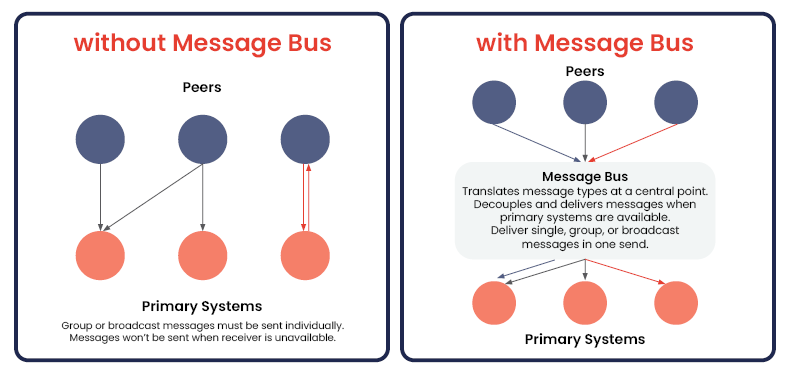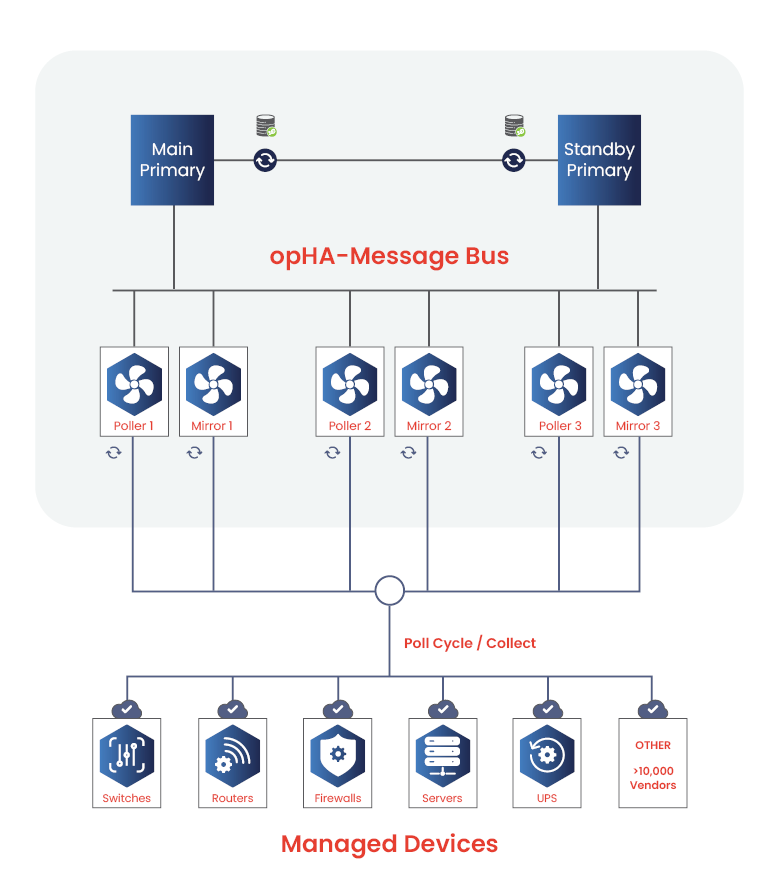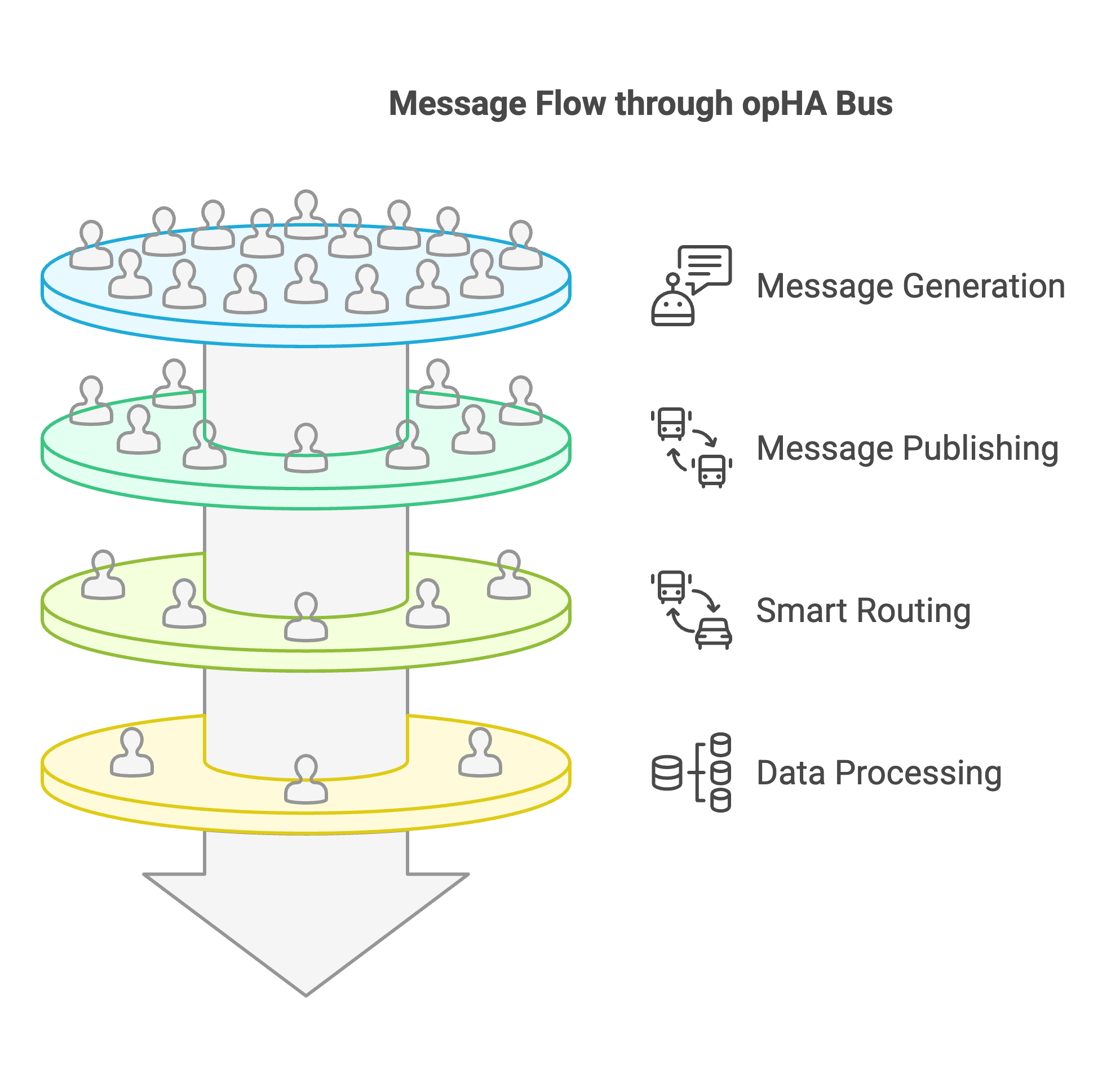12 February 2025
A Guide to Message Bus

Discover how this central communication system enables you to scale and decouple your communication in a distributed network architecture.
As businesses increasingly rely on distributed systems and microservices to serve their growing networks, effective communication between their different components becomes more challenging.
Enter message bus, or enterprise service bus: a communication system enabling seamless data exchange between network components to help you manage your distributed network.
In this blog, we’ll break down the concept of a message bus architecture, explaining how it works, its core features, available alternatives, and the benefits that a message bus solution like FirstWave opHA-MB brings to distributed systems.
Table of Contents
- What is message bus?
- Key components of a message bus architecture
- The benefits of message bus
- Common use cases for message bus technology
- Alternatives to message bus
- When to use which architecture
- The ultimate message bus solution: opHA Message Bus
What is message bus?
Imagine a bustling city with numerous neighborhoods, each representing a different application or service. To keep the city running smoothly, these neighborhoods need to exchange information efficiently.
A message bus acts like the city’s central transit system, ensuring messages are delivered to the right destinations without requiring any direct connections between them. In technical terms, the message bus enables different applications, services, or systems to communicate by transmitting messages through a shared infrastructure.
This setup ensures that each component remains independent for flexibility and scalability.
Key components of a message bus architecture
1. Producers (pollers)
Also known as peers, pollers collect data from various network devices and systems, generating messages that contain critical information about network performance, events, and statuses. These pollers can be scaled horizontally or vertically for efficient data collection across expansive networks.
2. Broker (message bus)
Serving as the central communication hub, the message bus ensures real-time synchronization among multiple pollers. It manages the routing of messages from producers to consumers, maintaining data integrity through message replication across three nodes, which allows the system to tolerate single-node failures.
3. Consumers (primary server and applications)
The primary server and associated applications function as consumers. They receive and process messages relayed by the message bus, providing users with a consolidated, real-time view of network health and performance. This setup enhances capabilities like event logging, monitoring, and the generation of intuitive dashboards and reports.
A message bus decouples communication, instead allowing senders and receivers to operate independently so network communication can happen asynchronously. This means users can manage distributed network systems via a central point that standardizes disparate communication styles. The result: a simple, integrated system.

The benefits of message bus
A message bus architecture is useful for businesses managing large-scale, distributed, multi-customer, and/or mission-critical networks, as data is freely available to travel between endpoints as needed.
- Multi-tenancy support: Especially for Managed Service Providers (MSPs), managing multiple clients efficiently is critical. A message bus architecture is designed for multi-tenancy, allowing MSPs to handle multiple customer environments within a single infrastructure.
- Fault tolerance: To ensure uninterrupted operations, many message buses (including opHA Message Bus) are built with fault tolerance and redundancy mechanisms that keep services running even if individual components fail.
- Flexibility: Scale your architecture with minimal configuration as decoupled components can operate and change independently. Easily handle high-traffic scenarios with the ability to distribute single messages across multiple consumers.
- Managed distribution: Message bus solves the problem of temporal decoupling, as peers and the primary do not need to be online simultaneously for the system to work. Messages can also be delivered in either single, group, or broadcast models.
- Reduced delays: Receive events to the primary system in real time, and process new events with minimal to no downtime.
- No API calls: Unlike traditional communication, where both services must be available simultaneously, a message bus can communicate at any time as well as rapidly push inventory updates.
- Reliability: Messages can be stored temporarily to prevent data loss, and retry mechanisms are supported if a consumer fails.
- Security: Authentication can be configured to control who sends and receives messages, and encryption can (and should) be incorporated to maintain secure communication.
- Monitoring: Track message flows for debugging, auditing, and performance monitoring.
Common use cases for message bus technology
1. Microservices architecture
In modern network management and cybersecurity environments, different services handle distinct functions—such as network monitoring, security alerts, performance analytics, and automation workflows—while seamlessly communicating with each other. A good message bus acts as the backbone for this communication, ensuring that services remain loosely coupled, scalable, and resilient in distributed architectures.
Network management benefits for microservices include:
- Seamless data flow: Ensures real-time data exchange between network monitoring tools, security systems, and reporting dashboards.
- Scalability: Allows IT teams and MSPs to add or modify monitoring components without affecting the entire system.
- Reduced latency and bottlenecks: Distributes network event data efficiently, preventing system slowdowns.
- Asynchronous processing: Enables automated alerts, log analysis, and device polling without delays.
2. Event-driven systems
Modern applications rely on real-time event processing to improve responsiveness and automation. A message bus is a core component of event-driven architectures, where events (e.g., user actions, system changes, external triggers) are published and consumed dynamically.
Where it’s useful:
- IoT networks: Devices publish sensor data, and analytics engines process it instantly.
- Cybersecurity monitoring: Suspicious activity is flagged and sent to security systems in real time.
- Finance and banking: Fraud detection systems react instantly to unusual transactions.
Alternatives to message bus
Alternatives to a message bus are usually point-to-point based, where services communicate directly rather than via a central interconnected point.
Point-to-point communication has its benefits, but it does limit your capabilities in that it silos data between sender and receiver, preventing cross-communication which can limit efficiency in more complex architectures.
But the good news is that you’re not just limited to one option; your distributed system can use a combination of communication styles for different functions to optimize its efficiency for your business.
APIs
APIs are a tightly coupled solution where each of your services need to know about each of your endpoints. With APIs, each service manages its own connections. This approach is ideal for simpler architectures or where latency isn’t a major consideration.
Pros:
- Suits synchronous interactions: APIs work when a service needs an immediate response and can’t be held or queued.
- Easy to implement: APIs are ideal in small-scale applications where adding a message bus would be overkill.
- Easy to integrate: APIs allow messages to be externally exposed to public or partner systems through simple calls.
Cons:
- Failure recovery challenges: Failure recovery mechanisms are harder to implement as services handle errors individually.
- Request bottlenecks: Too many requests can overload an API-driven system, leading to delays or failures.
- Limited scalability: API-driven systems are difficult to scale as each service directly communicates with others, increasing management complexity.
- Workflow issues: Performance and reliability suffer in asynchronous workflows like order processing or event-driven systems.
- High-throughput limitations: High-throughput systems that need decoupling and scalability can’t be supported, as each service manages its own connections.
Message queuing
A message queue is similar to a message bus, but they differ in how messages are routed and processed. Unlike a message bus, a message queue uses point-to-point communication and messages are prioritized by first in, first out. Once consumed, the message is simply removed from the queue.
Pros:
- Simple security: One-to-one messaging circumvents the need to implement encryption or similar security measures.
- Easy to implement: Ideal for task-based workflows, background jobs, or small applications with a clear producer-consumer relationship.
- Message durability: Messages can be persisted in the queue, ensuring they’re not lost even if the consumer is unavailable.
Cons:
- Limited communication: No built-in publish-subscribe model is available, limiting communication to one-to-one scenarios.
- No prioritization: There is no ability to prioritize or triage messages.
- Complex management: Managing message queues becomes more difficult at scale, and eventually totally inefficient.
- Potential for bottlenecks: With no ability to prioritize or triage messages, important messages can pile up in a queue if a consumer is overwhelmed or unavailable.
When to use which architecture
- APIs provide a tightly coupled solution, where each of your services need to know about each of your endpoints. If you use them on your own, you’re limited by point-to-point communication only, but APIs can form a useful part of a larger combination of communication architectures.
- Message queuing can be easy to implement for simple networks that manage only task-based workflows and point-to-point communication. But they’re not always easy to manage, as queue-based solutions typically require monitoring to ensure the queue doesn’t come too large, creating a bottleneck. They also require some form of orchestration to handle message processing.
- A message bus architecture is best suited for event-driven architectures, real-time updates, and systems where messages need to be broadcast to multiple consumers, e.g. notification systems, microservices communication. Message bus is also ideal for its ability to scale with your network as it grows over time, and integrates more complex or mission-critical communication systems.
If you have the time to implement and manage them all efficiently, you can use a message bus alongside other communication methods to expand your feature scope and optimize your setup for different use cases.
Some single providers will provide all of these functionalities in-house to make your journey even easier; for example, in addition to FirstWave’s opHA Message Bus solution, we also provide APIs to allow for message transfers, as well as integrate with queue-based message brokers such as RabbitMQ – all combined with hands-on expert support to make implementation easy.
Which is right for me?
To help you choose the best design (or combination of designs) for your business, ask yourself the following questions:
- Do we require or would we benefit from event-driven architecture?
- What level of decoupling do we need? Which services (if any) need the ability to communicate asynchronously?
- How critical is real-time communication? Do we need instant responses, near real-time event-driven updates, or delayed processing?
- What is our expected message volume and load on our services?
- How will we build resilience into our network? Do we need fault-tolerant messaging or constant availability?
- How important is scalability now, and what are our long-term growth plans?
- How do we plan to adopt AI or ML into our network, and how do we expect this to impact our network communication patterns?
The ultimate message bus solution: opHA Message Bus
opHA Message Bus (opHA-MB) is FirstWave’s own message bus solution, enabling you to simplify management of your distributed network systems with real-time data transfer across diverse and multi-tenanted environments.
This advanced network management solution acts as the central nervous system to your network to help you maintain optimal network performance, ensure resilience, and swiftly resolve the issues that come with complex network infrastructure.

How messages flow through opHA-MB
- Generating messages: Pollers collect data from network devices and generate messages containing key information.
- Publishing to the bus: These messages are sent to opHA-MB, which acts as the central broker.
- Smart routing: opHA-MB identifies which applications or services (consumers) need the data and directs messages accordingly.
- Processing and action: Consumers, such as the primary server, opCharts, and opEvents, receive the messages, process the data, and trigger the necessary actions, such as alerts or dashboard updates.
By keeping producers and consumers decoupled, this architecture allows each component to function independently. This improves flexibility, scalability, and resilience—ensuring efficient network management even as demands grow.

Features of opHA-MB
- Multi-tenancy: Managed Service Providers (MSPs) can easily manage multiple tenants with a single, configurable interface.
- Real-time communication and event management: Reduce data transfer times with real-time sync between multiple pollers, and enhance Mean Time to Resolve (MTTR) with immediate event notifications from pollers to the primary server.
- Fault tolerance: Ensure data integrity with message replication across three nodes, tolerating single-node failures.
- Multi-server architecture: Distribute the server load to multiple pollers for efficient data collection and processing.
- Provisioning management: Simplify platform provisioning with push changes and new poller deployment at the click of a button.
- Scaling for high availability: Scale pollers horizontally or vertically with mirroring to improve availability, redundancy, and flexibility across your architecture.
- Integration with FirstWave products: opHA-MB is designed to work seamlessly with other FirstWave products, including opEvents and opCharts, to enhance your network management capabilities.
Key benefits of opHA-MB
- Unparalleled network visibility: Gain instant insights into your network with immediate event updates, empowering proactive issue resolution.
- Enhanced network resilience: Minimize downtime and ensure uninterrupted service delivery with automated failover mechanisms and resilient event transfer.
- Event prioritization: When you use opHA-MB as part of your FirstWave suite of solutions, your data is prioritized by our software to enable intuitive event prioritization with real-time notifications, so you can address the events that matter most to your business.
- Streamlined network management: Reduce manual intervention and optimize network management tasks with automated event processing and centralized data management.
- Scalable and flexible architecture: Grow your architecture with your business and make changes as needed, with the ability to scale pollers horizontally or vertically.
- Reduced delays: Receive events to your primary system in real time to process new events with minimal to no downtime, as well as zero event loss in high-traffic environments.
- No API calls: Push inventory updates to multiple systems instantly and automatically.